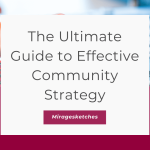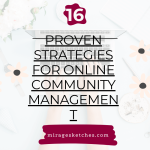Creating a content strategy for your online community is essential to keep your members engaged and active.
I’ve learned this from experience.
When I first started, it felt like I was posting into a void.
But as I experimented, things started working.
Below, I’ll walk you through how I developed a strategy that works.
Identify Your Online Community’s Needs
Before anything else, you need to understand who your community is and what they want.
I didn’t figure this out at first, and I ended up creating content that didn’t resonate with anyone.
But once I took a step back and thought about my audience, everything changed.
Ask yourself:
What topics do they care about?
What kind of problems are they facing?
How do they prefer to consume content videos, blogs, or images?
You don’t have to guess either.
Use surveys or simply ask your members directly what they want.
In my case, I found that people loved quick tips and advice, so I started sharing more of that.
Set Clear Goals for Your Content Strategy
Now that you know your audience, you need to set clear goals for your content.
If you’re posting without any clear objective, it’s hard to measure success.
What are you trying to achieve?
Some common goals for an online community might include:
Increasing member engagement
Growing the community size
Driving traffic to a website or landing page
Educating members about a specific topic
For me, the goal was to get more people commenting and sharing their thoughts.
So I focused on making my posts interactive by asking questions and encouraging discussion.
Plan Your Content in Advance
One of the biggest mistakes I made early on was posting randomly without a schedule.
At first, I would post whenever I felt like it, thinking that being spontaneous was a good thing.
But I quickly realized that it’s much better to have a plan.
Creating a content calendar made everything easier.
I planned out what I was going to post for the week, and it saved me from the stress of last-minute posting.
It’s like knowing what’s for dinner every night instead of scrambling to figure it out.
You don’t have to post every single day, but having some consistency is key.
For example, I post every Monday and Thursday.
That way, my community knows when to expect new content.
Post at Optimal Times
Timing matters.
This is something I didn’t understand at first.
I used to post in the middle of the night when most of my community was asleep, and I wondered why my engagement was so low.
It turns out, posting when your members are online is crucial.
Different communities have different activity patterns.
For my community, I found that mornings and early evenings worked best.
You can use insights from social media platforms to see when your audience is most active, and schedule your posts for those times.
Mix Up Your Content Formats
Variety is the spice of life and of community content!
Mixing up your content formats keeps things fresh.
People don’t want to read long posts all the time, and sometimes they just want something fun or easy to digest.
Here are some ideas:
Use images and memes
Post short video clips
Share polls or surveys
Create infographics
One thing that worked for me was sharing memes.
I thought it was a silly idea at first, but people loved it.
They engaged more with a funny meme than they did with a long article, and that helped boost overall engagement.
Encourage Community Interaction
A good content strategy isn’t just about posting.
It’s also about creating opportunities for interaction.
I found that when I asked open-ended questions, my community came to life.
People started commenting, sharing their thoughts, and interacting with each other.
One simple trick is to end every post with a question.
For example, instead of just giving advice, ask, “What do you think? Have you tried this before?” It invites people to share their own experiences.
Another thing you can do is run polls or quizzes.
These are easy ways to get people talking and clicking, which increases overall engagement.
Be Consistent but Flexible
Consistency is key to any good content strategy.
However, being consistent doesn’t mean you have to stick rigidly to the plan all the time.
Sometimes things change, and you need to be flexible.
For instance, I planned a whole week of posts, but then a big event happened in my industry, so I pivoted and posted about that instead.
You don’t want to ignore important trends or topics just because they weren’t in your plan.
If your community starts talking about something new, jump on it.
You’ll get better engagement if you join the conversation they’re already having.
Track What’s Working (and What’s Not)
How do you know if your content strategy is working? You need to track your results.
At first, I thought I was doing great because I was posting regularly, but when I looked at the engagement stats, I realized some types of posts weren’t resonating with my audience.
Look at things like:
Post engagement (likes, comments, shares)
Number of new members joining
Traffic to your website
Click-through rates (CTR)
By tracking these metrics, you can see what’s working and what needs improvement.
If certain types of content aren’t performing well, try something different.
Keep It Simple and Clear
I used to think that the more complicated my posts were, the more value I was providing.
I was wrong.
The simpler my content became, the better it performed.
Keep things simple and easy to understand.
People don’t have time to read long, complex articles.
They want quick, clear content they can digest in a few minutes.
In my community, I started using bullet points, short sentences, and lots of visuals to make everything more readable.
Create a Feedback Loop
Your community members are your best source of inspiration.
Ask them for feedback regularly and use that to improve your content strategy.
I started sending out short surveys and asking for comments on what they liked and didn’t like.
This not only helps you improve your strategy, but it also makes your members feel involved.
They’re more likely to stay engaged if they feel like their opinions matter.
Final Thought
Creating a content strategy for your online community isn’t rocket science, but it does require some thought and planning.
Start by knowing your audience, setting clear goals, and creating a mix of content formats.
Don’t forget to encourage interaction and keep things simple.
Track what’s working and be flexible enough to change when needed.
By following these steps, you’ll build a thriving community that stays engaged
Remember, the key to a successful strategy is consistency and adaptation.
Your community will grow over time, and so will your content strategy.





